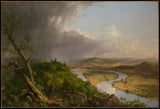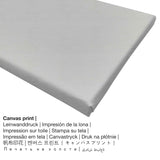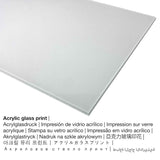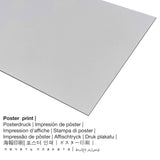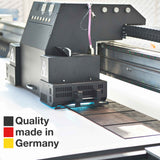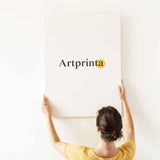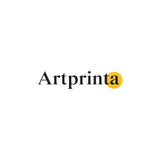Thomas Cole, 1836 - Nlegharị anya site na Ugwu Holyoke, Northampton, Massachusetts, mgbe oke mmiri ozuzo gasịrị—The Oxbow - ọmarịcha nka.
Ụtụ gụnyere. Mbupu gbakọrọ na ndenye ọpụpụ.
Ozi mgbakwunye sitere n'aka Ụlọ ihe ngosi nka nke Obodo ukwu (© - site n'aka The Metropolitan Museum of Art - Museumlọ ihe ngosi nka nke Obodo)
Long known as "The Oxbow," this work is a masterpiece of American landscape painting, laden with possible interpretations. In the midst of painting "The Course of Empire" (New-York Historical Society), Cole mentioned in a letter dated March 2, 1836, to his patron Luman Reed that he was executing a large version of this subject expressly for exhibition and sale. The picture was shown at the National Academy of Design in 1836 as "View from Mount Holyoke, Northampton, Massachusetts, after a Thunderstorm." Cole's interest in the subject probably dates from his 1829–32 trip to Europe, during which he made an exact tracing of the view published in Basil Hall's "Forty Etchings Made with the Camera Lucida in North America in 1827 and 1828." Hall criticized Americans' inattentiveness to their scenery, and Cole responded with a landscape that lauds the uniqueness of America by encompassing "a union of the picturesque, the sublime, and the magnificent." Although often ambiguous about the subjugation of the land, here the artist juxtaposes untamed wilderness and pastoral settlement to emphasize the possibilities of the national landscape, pointing to the future prospect of the American nation. Cole's unequivocal construction and composition of the scene, charged with moral significance, is reinforced by his depiction of himself in the middle distance, perched on a promontory painting the Oxbow. He is an American producing American art, in communion with American scenery. There are both sketchbook drawings with annotations and related oil sketches of this subject. Many other artists copied or imitated the painting.
Mpempe akwụkwọ nka mara mma nkeonwe gị
Nke a karịrị 180 mpempe nka View from Mount Holyoke, Northampton, Massachusetts, after a Thunderstorm—The Oxbow onye na-ese ihe sere ya Thomas Cole. The 180 year-old original of the painting measures the size: 51 1/2 x 76 inch (130,8 x 193 cm). Oil on canvas was used by the painter as the technique for the painting. The piece of art belongs to the Ụlọ ihe ngosi nka nke Metropolitan nchịkọta nka dijitalụ. Site n'ikike nke: The Metropolitan Museum of Art, New York, Gift of Mrs. Russell Sage, 1908 (license: public domain). In addition to that, the work of art has the creditline: Gift of Mrs. Russell Sage, 1908. N'elu nke ahụ, nhazi nke mmepụta dijitalụ bụ odida obodo ma nwee oke akụkụ nke 3: 2, nke pụtara na ogologo bụ 50% ogologo karịa obosara. Thomas Cole was a male painter, whose art style can be attributed primarily to Romanticism. The North American artist was born in the year 1801 in Lancashire, England, United Kingdom, county and deceased at the age of 47 in the year 1848.
Kedu ihe ga-abụ ihe ebipụta nka kacha amasị gị?
Anyị na-enye ụdị dị iche iche nha na ihe maka ngwaahịa ọ bụla. Ị nwere ike ịhọrọ n'ime nhọrọ nhazi ngwaahịa ndị a:
- Mbipụta kanvas: A printed canvas, which should not be mistaken with a canvas painting, is a digital image applied directly on canvas fabric. Furthermore, a canvas print generates a cosy, comfy appearance. A canvas print of your favorite work of art will allow you to transform your into a large size work of art. Hanging a canvas print: A canvas print has the advantage of being low in weight, which means that it is easy and straightforward to hang your Canvas print without the help of additional wall-mounts. That is why, canvas prints are suitable for all kinds of walls.
- Bipụta na iko acrylic na-egbuke egbuke (nke nwere ezigbo mkpuchi iko): An print on acrylic glass, often named a plexiglass print, will change your favorite original into décor and offers a distinct alternative option to aluminium and canvas prints. The major advantage of a plexiglass art print is that contrasts and small artwork details will be more recognizeable with the help of the fine gradation in the picture. The acrylic glass protects your chosen fine art print against light and external influences for many decades.
- Mbipụta aluminom (aluminium dibbond): Aluminium Dibond prints are prints on metal with an impressive depth effect - for a modern impression and non-reflective surface. For the Aluminium Dibond print, we print your selected work of art onto the surface of the aluminum. The colors are luminous, the fine details are very clear.
- Mbipụta akwụkwọ mmado (ihe kwaaji): A poster is a UV printed sheet of canvas with a slight structure on the surface, which resembles the actual work of art. Please keep in mind, that depending on the absolute size of the poster print we add a white margin 2-6cm around the print, which facilitates the framing with your custom frame.
Nkọwa onye nka
| aha: | Thomas Cole |
| Aha ndị ọzọ: | Cole T., Thomas Cole, Cole, Cole Thomas |
| okike onye nka: | nwoke |
| Obodo onye nka: | American |
| Ọrụ nke onye na-ese ihe: | onye na-ese ihe |
| Mba onye si: | United States |
| Nkewa onye nka: | omenkà nke oge a |
| Ụdị nka: | Ihunanya |
| Nwụrụ na afọ nke: | 47 afọ |
| Afọ ọmụmụ: | 1801 |
| Obodo ọmụmụ: | Lancashire, England, United Kingdom, County |
| Nwuru: | 1848 |
| Nwuru na (ebe): | Catskill, Greene County, New York steeti, Njikota Obodo Amerika |
Iberibe ozi nka
| Aha nke eserese ahụ: | "View from Mount Holyoke, Northampton, Massachusetts, after a Thunderstorm—The Oxbow" |
| Nhazi nka: | sere |
| Okwu nche anwụ: | nkà nke oge a |
| Nhazi oge: | 19th narị afọ |
| Emepụtara n'afọ: | 1836 |
| Afọ nka: | 180 afọ |
| Ọkara nke ihe osise izizi: | mmanụ na kwaaji |
| Akụkụ nke nka nka izizi: | 51 1/2 x 76 inch (130,8 x 193 cm) |
| Egosiputara na: | Museumlọ ihe ngosi nka nke Obodo |
| Ebe ngosi nka: | New York City, New York, Njikota Obodo Amerika |
| Ebe nrụọrụ weebụ ihe ngosi nka: | Museumlọ ihe ngosi nka nke Obodo |
| License: | ngalaba ọha |
| Site n'aka: | The Metropolitan Museum of Art, New York, Gift of Mrs. Russell Sage, 1908 |
| kreditline ọrụ nka: | Gift of Mrs. Russell Sage, 1908 |
Ngwaahịa a
| Nkewa ngwaahịa: | ọmarịcha nka |
| Usoro mmeghari: | dijitalụ mmeputakwa |
| Usoro mmepụta: | UV kpọmkwem obibi |
| Mmalite ngwaahịa: | Germany |
| Ụdị ngwaahịa: | mmepụta ihe na-achọ |
| Eji ngwaahịa emebere: | Ụlọ ihe ngosi nka, ụlọ mgbidi |
| Ndozi onyonyo a: | usoro odida obodo |
| Oke akụkụ onyonyo: | 3:2- (ogologo: obosara) |
| Pụtara nha akụkụ onyonyo: | ogologo bụ 50% ogologo karịa obosara |
| Ụdị ihe dị iche iche dị: | Mpempe iko acrylic (nke nwere ezigbo mkpuchi iko), mbipụta ọla (aluminium dibond), mbipụta akwụkwọ mmado (akwụkwọ kwaaji), mbipụta kwaaji. |
| Nhọrọ nke Canvas Mbipụta (akwa akwa na etiti ihe ndọtị): | 30x20cm - 12x8", 60x40cm - 24x16", 90x60cm - 35x24", 120x80cm - 47x31", 150x100cm - 59x39" |
| Mbipụta iko acrylic (nke nwere ezigbo mkpuchi iko): | 30x20cm - 12x8", 60x40cm - 24x16", 90x60cm - 35x24", 120x80cm - 47x31", 150x100cm - 59x39" |
| Mbipụta akwụkwọ mmado (akwụkwọ kwaaji): | 60x40cm - 24x16", 90x60cm - 35x24", 120x80cm - 47x31" |
| Nhọrọ nha nke mbipụta aluminom (aluminium dibond material) | 30x20cm - 12x8", 60x40cm - 24x16", 90x60cm - 35x24", 120x80cm - 47x31" |
| Nhazi mbipụta nka: | agunyeghi |
Legal disclaimer: We try all that we can to describe the art products as accurate as possible and to illustrate them visually on the product detail pages. Please keep in mind that the colors of the printed materials, as well as the print result might diverge slightly from the representation on your device's screen. Depending on the settings of your screen and the condition of the surface, colors might not be printed as realistically as the digital version shown here. Because all the fine art prints are processed and printed by hand, there may as well be minor differences in the size and exact position of the motif.
© echebe nwebiisinka - Artprinta.com

